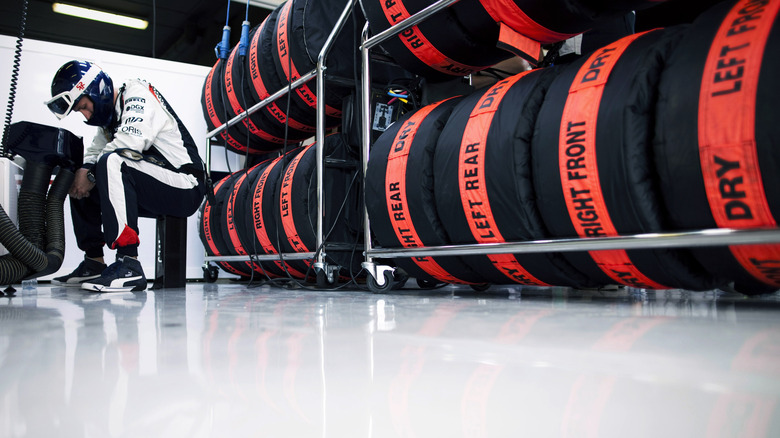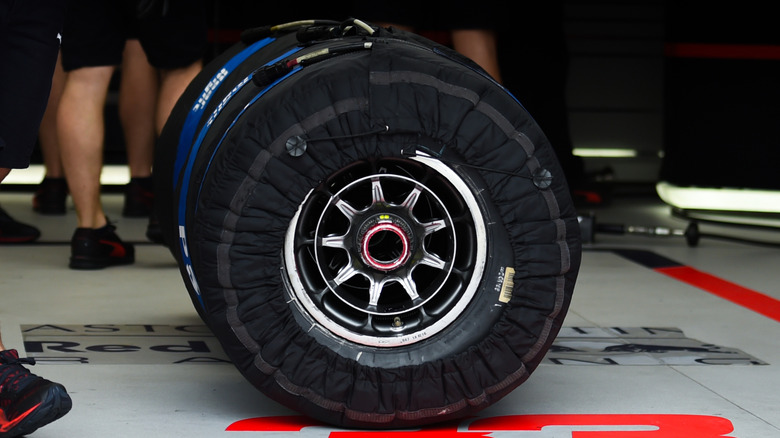What Are The Covers On F1 Tires For?
The forces experienced by the fastest Formula One cars in turns exceed virtually any other motorsport discipline. Consequently, their smooth tires represent the absolute bleeding-edge in terms of not just technology, but tolerances as well. In order to turn at rates exceeding 5G in hard, fast corners, tires arguably play a more critical role than any other component on the vehicle, given that — under ideal circumstances — the tires are the only elements in direct contact with the ground. So making sure that the tires perform at their best right out of the gate is crucial from both a consistency and safety perspective.
That's where tire blankets come in. These clever pieces of technology are used by F1 teams to preheat the tires to specific temperatures prior to being fitted on the car. Teams use the specialized covers to maintain strong, consistent handling. Without them, drivers would get released on ambient-temperature tires, which are far too cold for optimal grip. Pirelli, the official tire supplier of Formula One, lists specific tire guidelines on a per-track basis, determining which three of the five slick compounds will be used that weekend as well as their best settings like pressure and ideal camber angle.
Let's have a closer look at the blankets themselves — which are a deceptively interesting tool on their own — as well as the science behind why they're even needed at all. This includes the physics behind how the tire is heated and why the heat matters in producing grip.
What's in a tire blanket
Tire blankets are part of a larger system amounting to an insulated, electrically-heated cover that fully-encloses a single tire. The package is composed of several components. First, you have the heat source, namely a flexible heated element housed in a conductive gel. This ensures that the heat spreads evenly throughout the entire circumference of a tire's carcass. Then you have the cover, which functions like a giant heating pad, providing an insulated specific temperature determined by an electric current. It's fastened to the tire with Velcro straps and drawstrings to help seal in the heat.
Teams aim for a temperature of 212 degrees Fahrenheit (100 Celsius) at the green lights, so they set a hotter temperature to allow the tires to cool when lining up on the grid. The tires are then stacked on specialized dollies with outlets to power the blankets.
The usage of tire blankets remains a topic of controversy throughout multiple disciplines, Formula One included. Some drivers and teams cite the safety risks involved in running on cold, inconsistent tires. Others note that cold tires may cause accidents after leaving the pit lane, influencing the outcome of the race.
Some disciplines, like IndyCar and Formula Two, have already banned blankets, leaving some to simply label all this as a skill issue, or claiming it'll lead to more one-stop pit strategies. Last, there's the question of sustainability. After all, the blankets aren't cheap — a set for a full race weekend can cost as much as a brand-new Corolla – not to mention the electricity needed to run all of them for all 20 cars.
Why do tires need heat?
It goes without saying, but tires are made of rubber. Depending on the compound, a tire may be more or less flexible, with the most flexible, stickiest rubber providing the most grip. That's because a road surface is uneven, and tires deform to fill in the gaps and cracks to provide the maximum contact area. The trade-off is that this wears a tire more quickly than a stiffer one, which is why hard tires last longer than softs. Heat generation matters here because a warmer tire will deform more readily than a cold one. This proportionally increases grip, up to the point where the tires will overheat and actually partially-melt.
Tires are heated through three different primary sources in Formula One. The first is the tire blanket, as we've already discussed. Next is through regular driving –- as a car subjects the tires to the varying forces associated with racing, it'll naturally build up heat through contact with the road surface like any other car. Drivers will aggressively swerve under a safety car to prevent the tires from cooling off by utilizing this friction. The final heat source is the brakes –- Formula One brakes reach well over 1,000 degrees Fahrenheit under hard deceleration.
As tires heat up and cool down over the course of a session, they'll gradually lose their inherent properties and wear. For a more detailed breakdown of why this happens, you can check out this video from the Chain Bear YouTube channel explaining tire wear in-depth.


